Ways to Increase Shareholder Value
VerifiedAdded on 2021/04/21
|7
|1853
|40
AI Summary
The assignment provides a detailed analysis of ways to increase shareholder value, including compliance with environmental sustainability policies, selecting right customers and suppliers, optimizing assets, and lowering cost of capital. It also highlights the importance of productivity and after-sales services in increasing revenue and gross profit. The document is based on various studies and research papers that emphasize the significance of stakeholder management theory and triple bottom line approach to business sustainability.
Contribute Materials
Your contribution can guide someone’s learning journey. Share your
documents today.
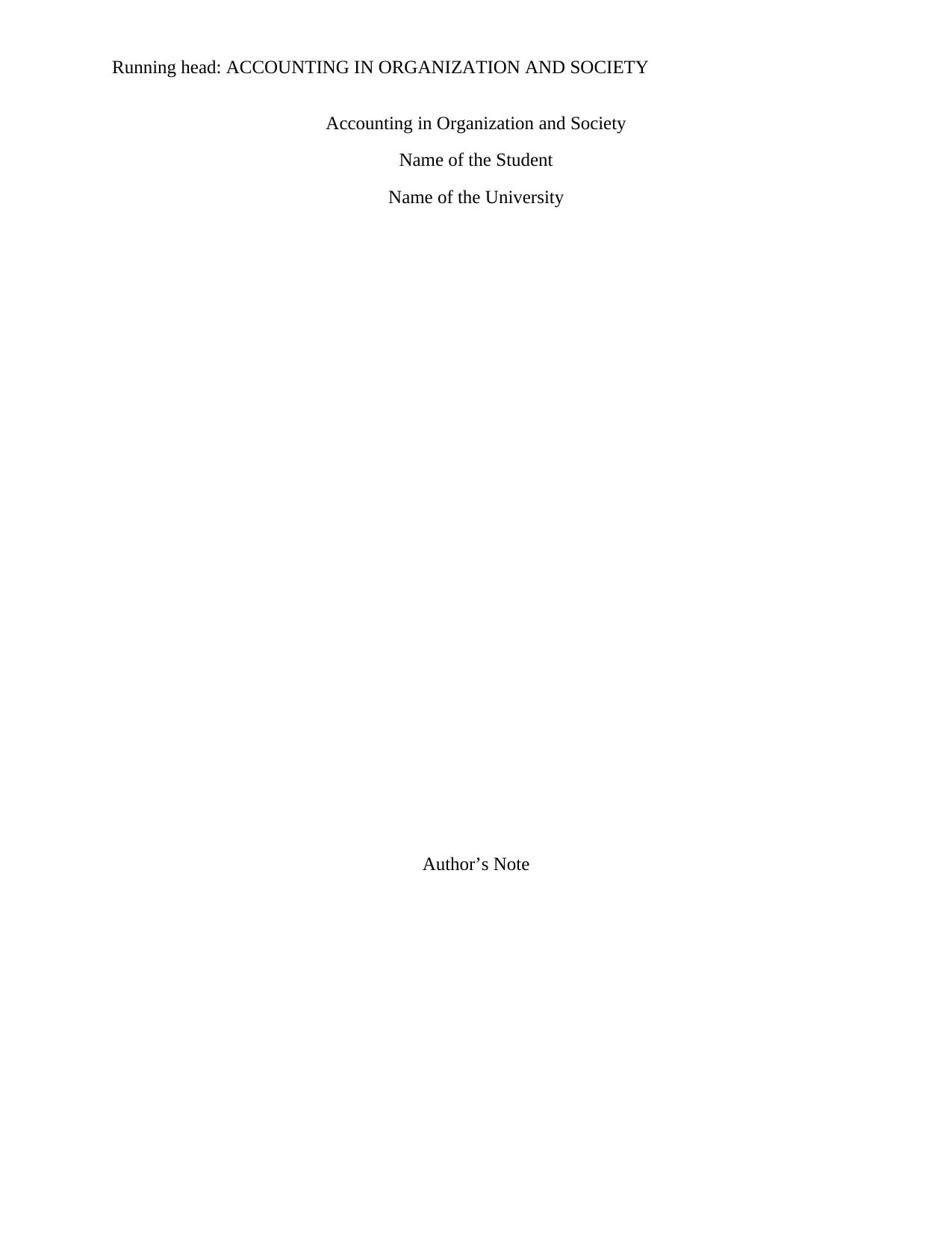
Running head: ACCOUNTING IN ORGANIZATION AND SOCIETY
Accounting in Organization and Society
Name of the Student
Name of the University
Author’s Note
Accounting in Organization and Society
Name of the Student
Name of the University
Author’s Note
Secure Best Marks with AI Grader
Need help grading? Try our AI Grader for instant feedback on your assignments.
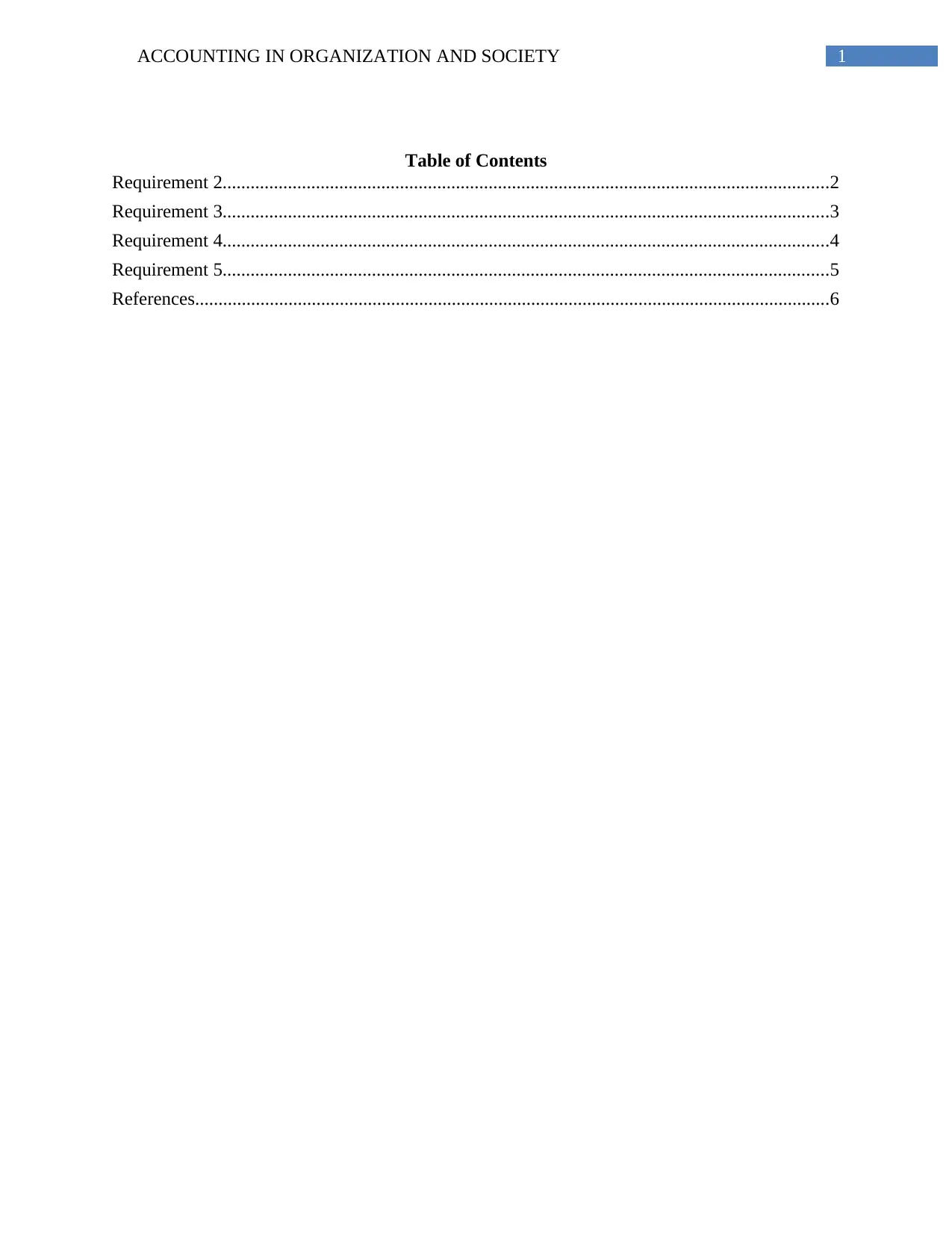
1ACCOUNTING IN ORGANIZATION AND SOCIETY
Table of Contents
Requirement 2..................................................................................................................................2
Requirement 3..................................................................................................................................3
Requirement 4..................................................................................................................................4
Requirement 5..................................................................................................................................5
References........................................................................................................................................6
Table of Contents
Requirement 2..................................................................................................................................2
Requirement 3..................................................................................................................................3
Requirement 4..................................................................................................................................4
Requirement 5..................................................................................................................................5
References........................................................................................................................................6
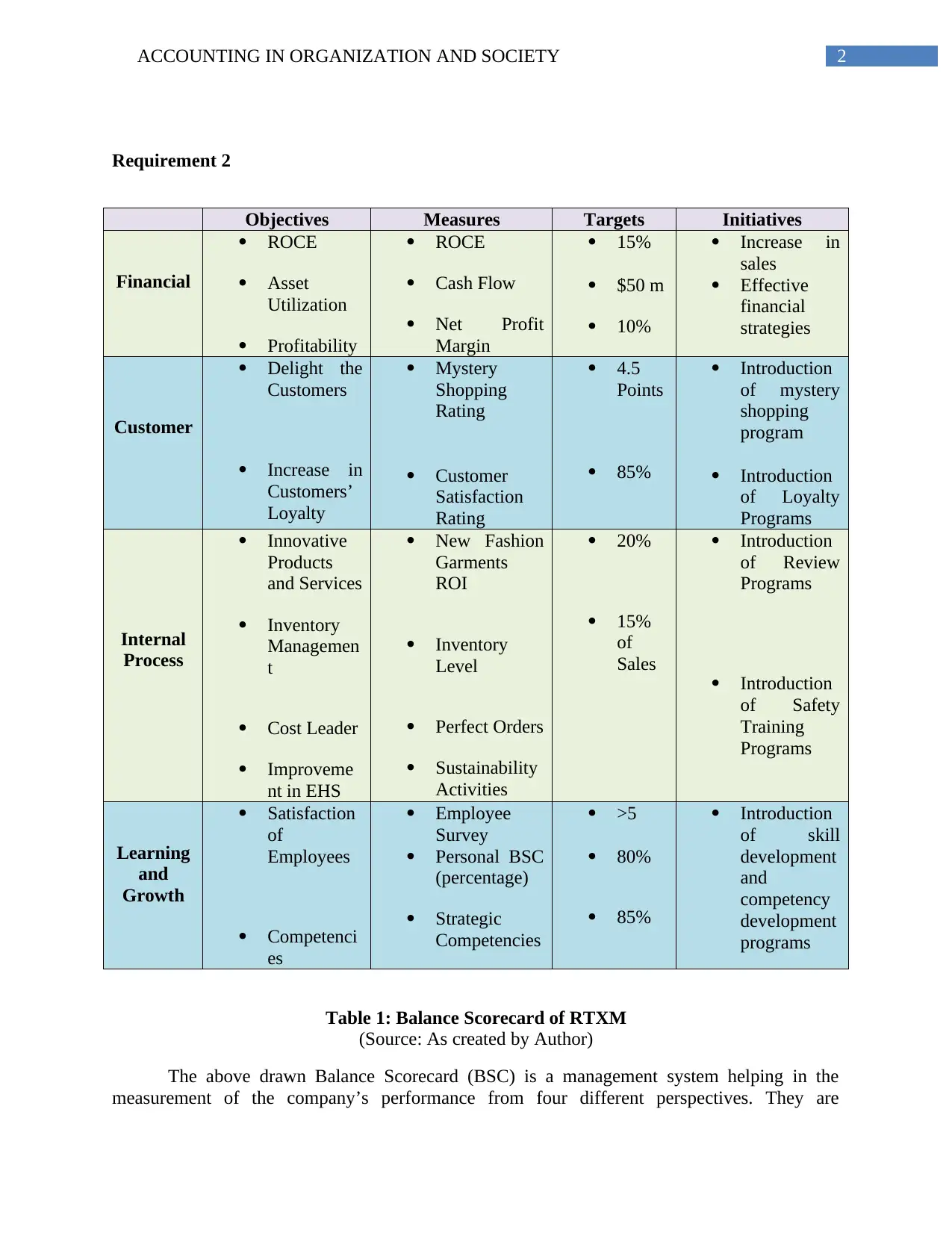
2ACCOUNTING IN ORGANIZATION AND SOCIETY
Requirement 2
Objectives Measures Targets Initiatives
Financial
ROCE
Asset
Utilization
Profitability
ROCE
Cash Flow
Net Profit
Margin
15%
$50 m
10%
Increase in
sales
Effective
financial
strategies
Customer
Delight the
Customers
Increase in
Customers’
Loyalty
Mystery
Shopping
Rating
Customer
Satisfaction
Rating
4.5
Points
85%
Introduction
of mystery
shopping
program
Introduction
of Loyalty
Programs
Internal
Process
Innovative
Products
and Services
Inventory
Managemen
t
Cost Leader
Improveme
nt in EHS
New Fashion
Garments
ROI
Inventory
Level
Perfect Orders
Sustainability
Activities
20%
15%
of
Sales
Introduction
of Review
Programs
Introduction
of Safety
Training
Programs
Learning
and
Growth
Satisfaction
of
Employees
Competenci
es
Employee
Survey
Personal BSC
(percentage)
Strategic
Competencies
>5
80%
85%
Introduction
of skill
development
and
competency
development
programs
Table 1: Balance Scorecard of RTXM
(Source: As created by Author)
The above drawn Balance Scorecard (BSC) is a management system helping in the
measurement of the company’s performance from four different perspectives. They are
Requirement 2
Objectives Measures Targets Initiatives
Financial
ROCE
Asset
Utilization
Profitability
ROCE
Cash Flow
Net Profit
Margin
15%
$50 m
10%
Increase in
sales
Effective
financial
strategies
Customer
Delight the
Customers
Increase in
Customers’
Loyalty
Mystery
Shopping
Rating
Customer
Satisfaction
Rating
4.5
Points
85%
Introduction
of mystery
shopping
program
Introduction
of Loyalty
Programs
Internal
Process
Innovative
Products
and Services
Inventory
Managemen
t
Cost Leader
Improveme
nt in EHS
New Fashion
Garments
ROI
Inventory
Level
Perfect Orders
Sustainability
Activities
20%
15%
of
Sales
Introduction
of Review
Programs
Introduction
of Safety
Training
Programs
Learning
and
Growth
Satisfaction
of
Employees
Competenci
es
Employee
Survey
Personal BSC
(percentage)
Strategic
Competencies
>5
80%
85%
Introduction
of skill
development
and
competency
development
programs
Table 1: Balance Scorecard of RTXM
(Source: As created by Author)
The above drawn Balance Scorecard (BSC) is a management system helping in the
measurement of the company’s performance from four different perspectives. They are
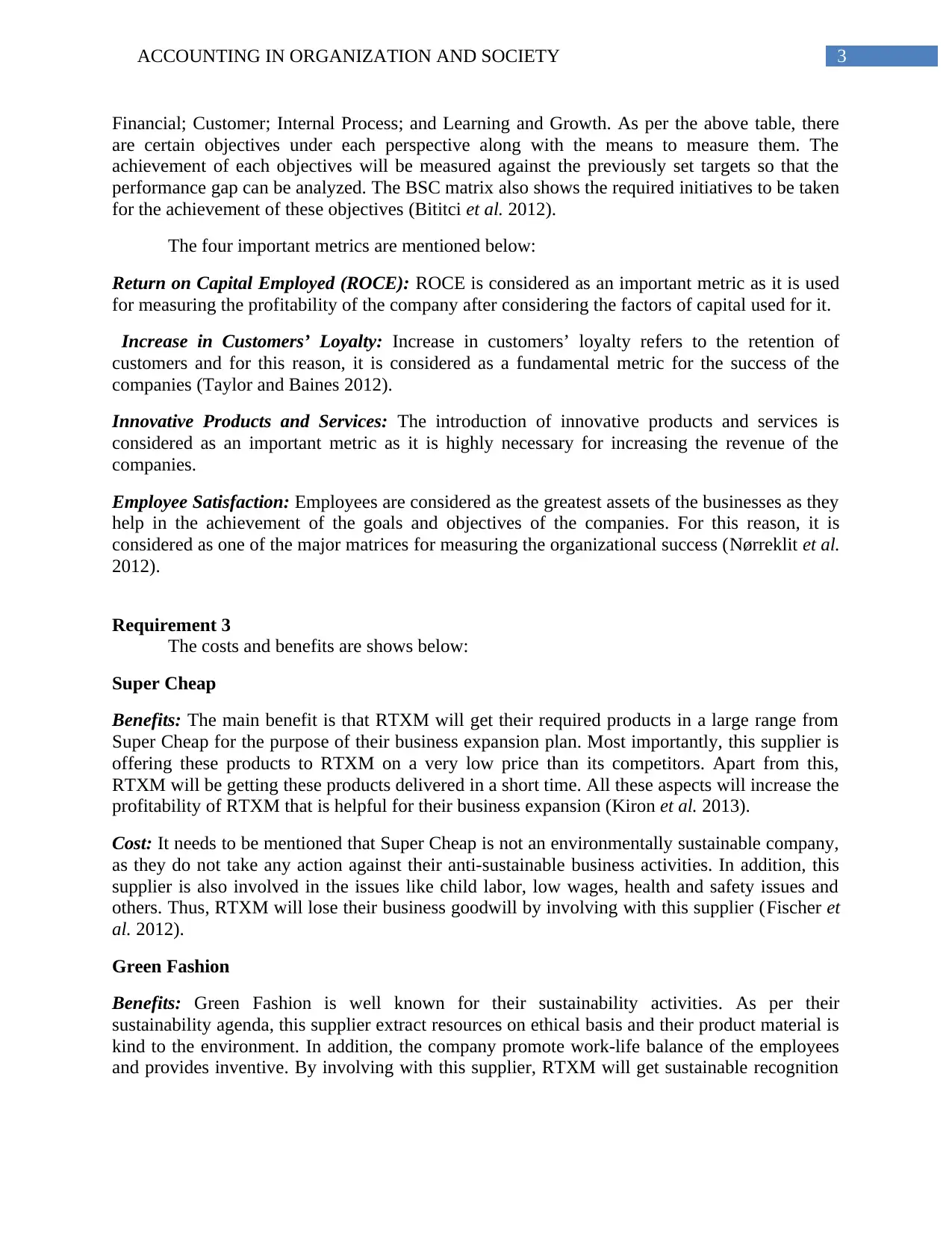
3ACCOUNTING IN ORGANIZATION AND SOCIETY
Financial; Customer; Internal Process; and Learning and Growth. As per the above table, there
are certain objectives under each perspective along with the means to measure them. The
achievement of each objectives will be measured against the previously set targets so that the
performance gap can be analyzed. The BSC matrix also shows the required initiatives to be taken
for the achievement of these objectives (Bititci et al. 2012).
The four important metrics are mentioned below:
Return on Capital Employed (ROCE): ROCE is considered as an important metric as it is used
for measuring the profitability of the company after considering the factors of capital used for it.
Increase in Customers’ Loyalty: Increase in customers’ loyalty refers to the retention of
customers and for this reason, it is considered as a fundamental metric for the success of the
companies (Taylor and Baines 2012).
Innovative Products and Services: The introduction of innovative products and services is
considered as an important metric as it is highly necessary for increasing the revenue of the
companies.
Employee Satisfaction: Employees are considered as the greatest assets of the businesses as they
help in the achievement of the goals and objectives of the companies. For this reason, it is
considered as one of the major matrices for measuring the organizational success (Nørreklit et al.
2012).
Requirement 3
The costs and benefits are shows below:
Super Cheap
Benefits: The main benefit is that RTXM will get their required products in a large range from
Super Cheap for the purpose of their business expansion plan. Most importantly, this supplier is
offering these products to RTXM on a very low price than its competitors. Apart from this,
RTXM will be getting these products delivered in a short time. All these aspects will increase the
profitability of RTXM that is helpful for their business expansion (Kiron et al. 2013).
Cost: It needs to be mentioned that Super Cheap is not an environmentally sustainable company,
as they do not take any action against their anti-sustainable business activities. In addition, this
supplier is also involved in the issues like child labor, low wages, health and safety issues and
others. Thus, RTXM will lose their business goodwill by involving with this supplier (Fischer et
al. 2012).
Green Fashion
Benefits: Green Fashion is well known for their sustainability activities. As per their
sustainability agenda, this supplier extract resources on ethical basis and their product material is
kind to the environment. In addition, the company promote work-life balance of the employees
and provides inventive. By involving with this supplier, RTXM will get sustainable recognition
Financial; Customer; Internal Process; and Learning and Growth. As per the above table, there
are certain objectives under each perspective along with the means to measure them. The
achievement of each objectives will be measured against the previously set targets so that the
performance gap can be analyzed. The BSC matrix also shows the required initiatives to be taken
for the achievement of these objectives (Bititci et al. 2012).
The four important metrics are mentioned below:
Return on Capital Employed (ROCE): ROCE is considered as an important metric as it is used
for measuring the profitability of the company after considering the factors of capital used for it.
Increase in Customers’ Loyalty: Increase in customers’ loyalty refers to the retention of
customers and for this reason, it is considered as a fundamental metric for the success of the
companies (Taylor and Baines 2012).
Innovative Products and Services: The introduction of innovative products and services is
considered as an important metric as it is highly necessary for increasing the revenue of the
companies.
Employee Satisfaction: Employees are considered as the greatest assets of the businesses as they
help in the achievement of the goals and objectives of the companies. For this reason, it is
considered as one of the major matrices for measuring the organizational success (Nørreklit et al.
2012).
Requirement 3
The costs and benefits are shows below:
Super Cheap
Benefits: The main benefit is that RTXM will get their required products in a large range from
Super Cheap for the purpose of their business expansion plan. Most importantly, this supplier is
offering these products to RTXM on a very low price than its competitors. Apart from this,
RTXM will be getting these products delivered in a short time. All these aspects will increase the
profitability of RTXM that is helpful for their business expansion (Kiron et al. 2013).
Cost: It needs to be mentioned that Super Cheap is not an environmentally sustainable company,
as they do not take any action against their anti-sustainable business activities. In addition, this
supplier is also involved in the issues like child labor, low wages, health and safety issues and
others. Thus, RTXM will lose their business goodwill by involving with this supplier (Fischer et
al. 2012).
Green Fashion
Benefits: Green Fashion is well known for their sustainability activities. As per their
sustainability agenda, this supplier extract resources on ethical basis and their product material is
kind to the environment. In addition, the company promote work-life balance of the employees
and provides inventive. By involving with this supplier, RTXM will get sustainable recognition
Secure Best Marks with AI Grader
Need help grading? Try our AI Grader for instant feedback on your assignments.
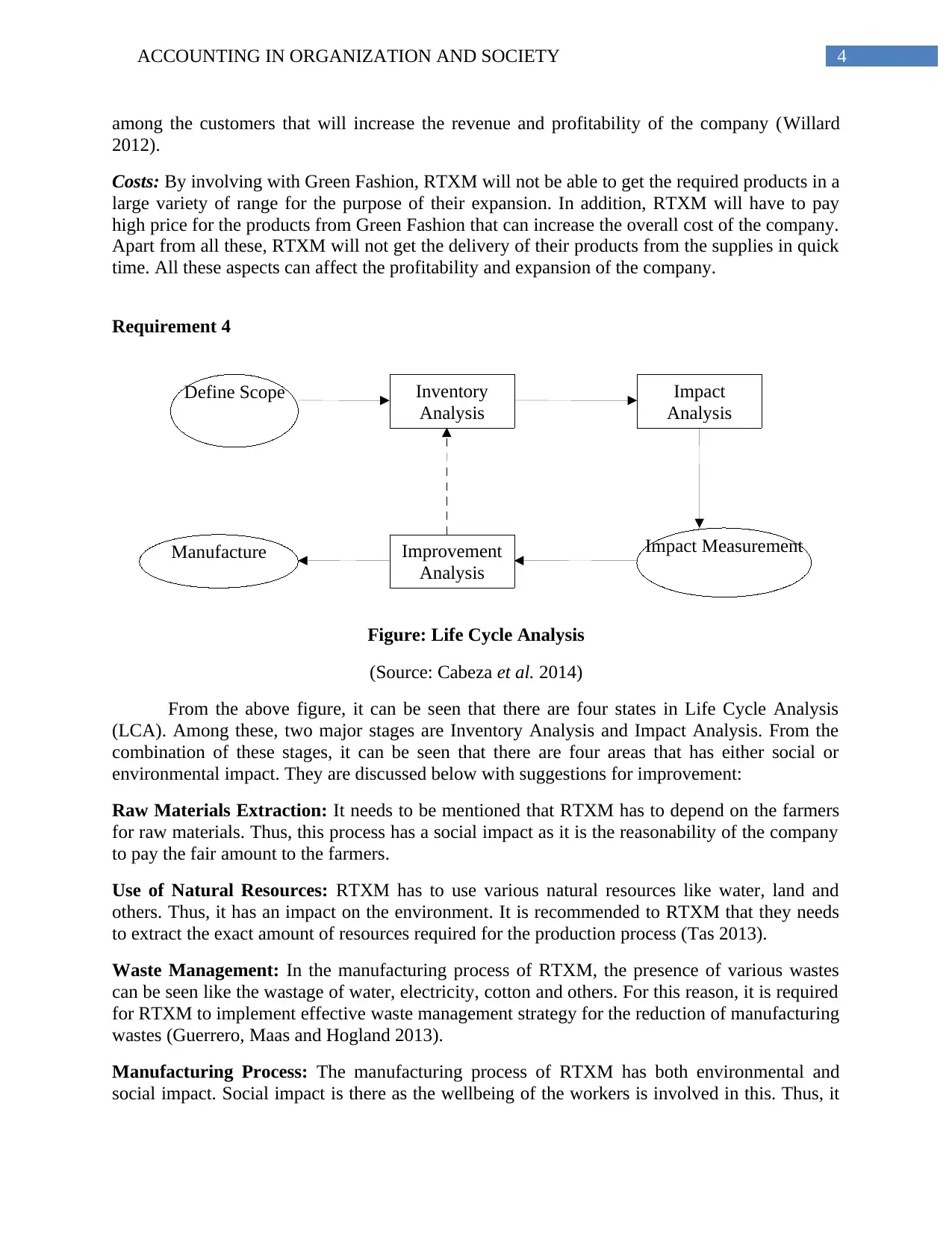
4ACCOUNTING IN ORGANIZATION AND SOCIETY
among the customers that will increase the revenue and profitability of the company (Willard
2012).
Costs: By involving with Green Fashion, RTXM will not be able to get the required products in a
large variety of range for the purpose of their expansion. In addition, RTXM will have to pay
high price for the products from Green Fashion that can increase the overall cost of the company.
Apart from all these, RTXM will not get the delivery of their products from the supplies in quick
time. All these aspects can affect the profitability and expansion of the company.
Requirement 4
Figure: Life Cycle Analysis
(Source: Cabeza et al. 2014)
From the above figure, it can be seen that there are four states in Life Cycle Analysis
(LCA). Among these, two major stages are Inventory Analysis and Impact Analysis. From the
combination of these stages, it can be seen that there are four areas that has either social or
environmental impact. They are discussed below with suggestions for improvement:
Raw Materials Extraction: It needs to be mentioned that RTXM has to depend on the farmers
for raw materials. Thus, this process has a social impact as it is the reasonability of the company
to pay the fair amount to the farmers.
Use of Natural Resources: RTXM has to use various natural resources like water, land and
others. Thus, it has an impact on the environment. It is recommended to RTXM that they needs
to extract the exact amount of resources required for the production process (Tas 2013).
Waste Management: In the manufacturing process of RTXM, the presence of various wastes
can be seen like the wastage of water, electricity, cotton and others. For this reason, it is required
for RTXM to implement effective waste management strategy for the reduction of manufacturing
wastes (Guerrero, Maas and Hogland 2013).
Manufacturing Process: The manufacturing process of RTXM has both environmental and
social impact. Social impact is there as the wellbeing of the workers is involved in this. Thus, it
Define Scope
Manufacture
Inventory
Analysis
Impact
Analysis
Improvement
Analysis
Impact Measurement
among the customers that will increase the revenue and profitability of the company (Willard
2012).
Costs: By involving with Green Fashion, RTXM will not be able to get the required products in a
large variety of range for the purpose of their expansion. In addition, RTXM will have to pay
high price for the products from Green Fashion that can increase the overall cost of the company.
Apart from all these, RTXM will not get the delivery of their products from the supplies in quick
time. All these aspects can affect the profitability and expansion of the company.
Requirement 4
Figure: Life Cycle Analysis
(Source: Cabeza et al. 2014)
From the above figure, it can be seen that there are four states in Life Cycle Analysis
(LCA). Among these, two major stages are Inventory Analysis and Impact Analysis. From the
combination of these stages, it can be seen that there are four areas that has either social or
environmental impact. They are discussed below with suggestions for improvement:
Raw Materials Extraction: It needs to be mentioned that RTXM has to depend on the farmers
for raw materials. Thus, this process has a social impact as it is the reasonability of the company
to pay the fair amount to the farmers.
Use of Natural Resources: RTXM has to use various natural resources like water, land and
others. Thus, it has an impact on the environment. It is recommended to RTXM that they needs
to extract the exact amount of resources required for the production process (Tas 2013).
Waste Management: In the manufacturing process of RTXM, the presence of various wastes
can be seen like the wastage of water, electricity, cotton and others. For this reason, it is required
for RTXM to implement effective waste management strategy for the reduction of manufacturing
wastes (Guerrero, Maas and Hogland 2013).
Manufacturing Process: The manufacturing process of RTXM has both environmental and
social impact. Social impact is there as the wellbeing of the workers is involved in this. Thus, it
Define Scope
Manufacture
Inventory
Analysis
Impact
Analysis
Improvement
Analysis
Impact Measurement
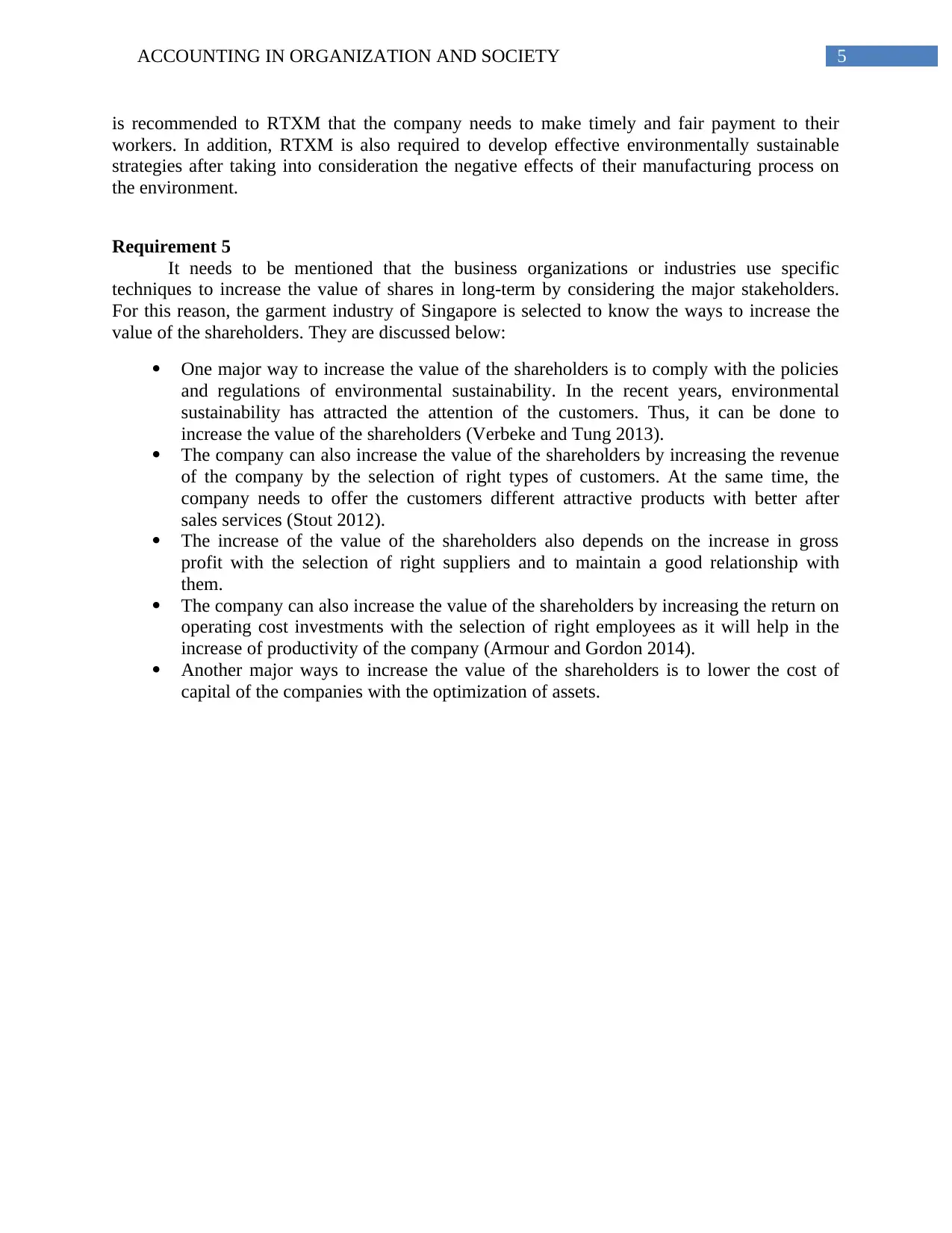
5ACCOUNTING IN ORGANIZATION AND SOCIETY
is recommended to RTXM that the company needs to make timely and fair payment to their
workers. In addition, RTXM is also required to develop effective environmentally sustainable
strategies after taking into consideration the negative effects of their manufacturing process on
the environment.
Requirement 5
It needs to be mentioned that the business organizations or industries use specific
techniques to increase the value of shares in long-term by considering the major stakeholders.
For this reason, the garment industry of Singapore is selected to know the ways to increase the
value of the shareholders. They are discussed below:
One major way to increase the value of the shareholders is to comply with the policies
and regulations of environmental sustainability. In the recent years, environmental
sustainability has attracted the attention of the customers. Thus, it can be done to
increase the value of the shareholders (Verbeke and Tung 2013).
The company can also increase the value of the shareholders by increasing the revenue
of the company by the selection of right types of customers. At the same time, the
company needs to offer the customers different attractive products with better after
sales services (Stout 2012).
The increase of the value of the shareholders also depends on the increase in gross
profit with the selection of right suppliers and to maintain a good relationship with
them.
The company can also increase the value of the shareholders by increasing the return on
operating cost investments with the selection of right employees as it will help in the
increase of productivity of the company (Armour and Gordon 2014).
Another major ways to increase the value of the shareholders is to lower the cost of
capital of the companies with the optimization of assets.
is recommended to RTXM that the company needs to make timely and fair payment to their
workers. In addition, RTXM is also required to develop effective environmentally sustainable
strategies after taking into consideration the negative effects of their manufacturing process on
the environment.
Requirement 5
It needs to be mentioned that the business organizations or industries use specific
techniques to increase the value of shares in long-term by considering the major stakeholders.
For this reason, the garment industry of Singapore is selected to know the ways to increase the
value of the shareholders. They are discussed below:
One major way to increase the value of the shareholders is to comply with the policies
and regulations of environmental sustainability. In the recent years, environmental
sustainability has attracted the attention of the customers. Thus, it can be done to
increase the value of the shareholders (Verbeke and Tung 2013).
The company can also increase the value of the shareholders by increasing the revenue
of the company by the selection of right types of customers. At the same time, the
company needs to offer the customers different attractive products with better after
sales services (Stout 2012).
The increase of the value of the shareholders also depends on the increase in gross
profit with the selection of right suppliers and to maintain a good relationship with
them.
The company can also increase the value of the shareholders by increasing the return on
operating cost investments with the selection of right employees as it will help in the
increase of productivity of the company (Armour and Gordon 2014).
Another major ways to increase the value of the shareholders is to lower the cost of
capital of the companies with the optimization of assets.
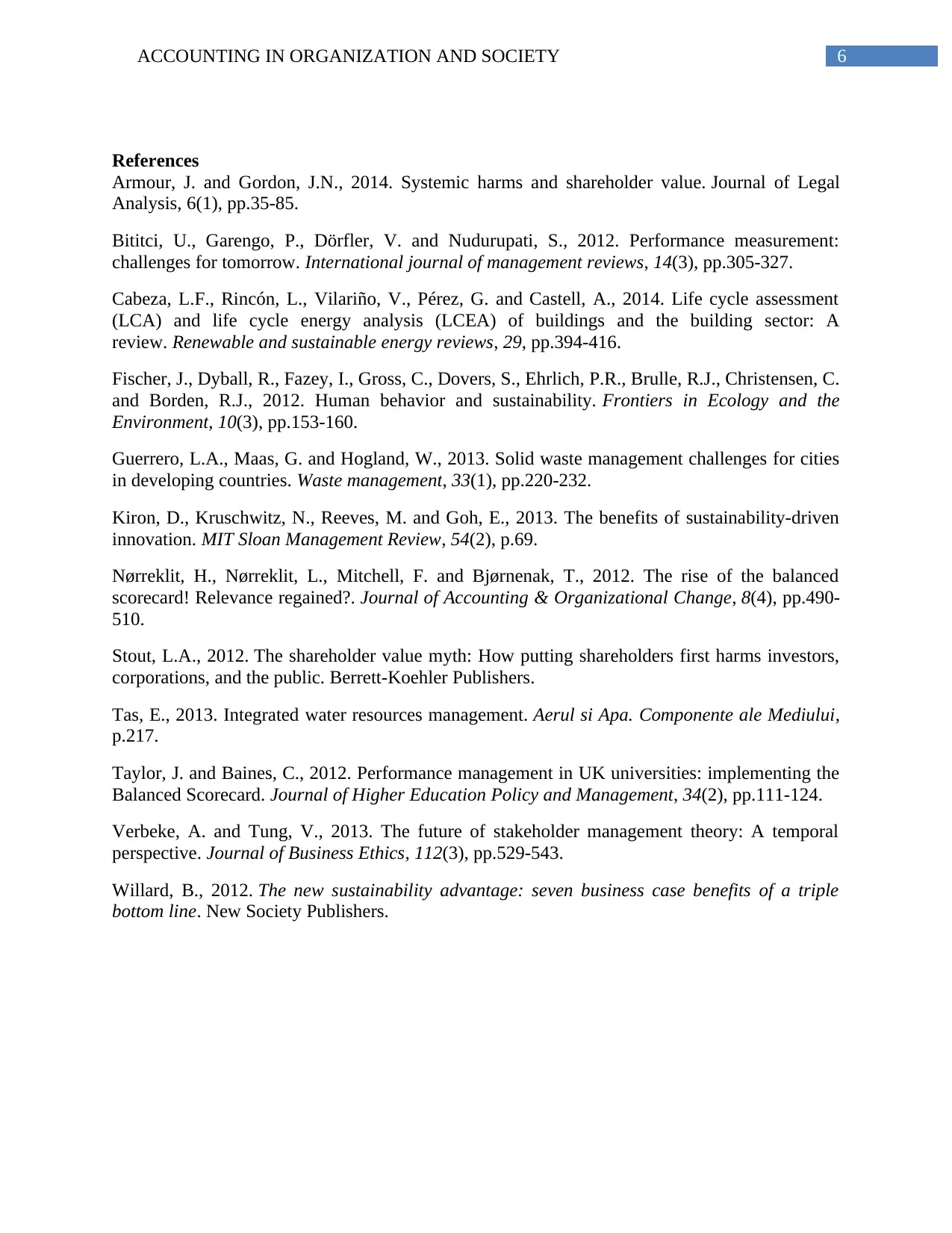
6ACCOUNTING IN ORGANIZATION AND SOCIETY
References
Armour, J. and Gordon, J.N., 2014. Systemic harms and shareholder value. Journal of Legal
Analysis, 6(1), pp.35-85.
Bititci, U., Garengo, P., Dörfler, V. and Nudurupati, S., 2012. Performance measurement:
challenges for tomorrow. International journal of management reviews, 14(3), pp.305-327.
Cabeza, L.F., Rincón, L., Vilariño, V., Pérez, G. and Castell, A., 2014. Life cycle assessment
(LCA) and life cycle energy analysis (LCEA) of buildings and the building sector: A
review. Renewable and sustainable energy reviews, 29, pp.394-416.
Fischer, J., Dyball, R., Fazey, I., Gross, C., Dovers, S., Ehrlich, P.R., Brulle, R.J., Christensen, C.
and Borden, R.J., 2012. Human behavior and sustainability. Frontiers in Ecology and the
Environment, 10(3), pp.153-160.
Guerrero, L.A., Maas, G. and Hogland, W., 2013. Solid waste management challenges for cities
in developing countries. Waste management, 33(1), pp.220-232.
Kiron, D., Kruschwitz, N., Reeves, M. and Goh, E., 2013. The benefits of sustainability-driven
innovation. MIT Sloan Management Review, 54(2), p.69.
Nørreklit, H., Nørreklit, L., Mitchell, F. and Bjørnenak, T., 2012. The rise of the balanced
scorecard! Relevance regained?. Journal of Accounting & Organizational Change, 8(4), pp.490-
510.
Stout, L.A., 2012. The shareholder value myth: How putting shareholders first harms investors,
corporations, and the public. Berrett-Koehler Publishers.
Tas, E., 2013. Integrated water resources management. Aerul si Apa. Componente ale Mediului,
p.217.
Taylor, J. and Baines, C., 2012. Performance management in UK universities: implementing the
Balanced Scorecard. Journal of Higher Education Policy and Management, 34(2), pp.111-124.
Verbeke, A. and Tung, V., 2013. The future of stakeholder management theory: A temporal
perspective. Journal of Business Ethics, 112(3), pp.529-543.
Willard, B., 2012. The new sustainability advantage: seven business case benefits of a triple
bottom line. New Society Publishers.
References
Armour, J. and Gordon, J.N., 2014. Systemic harms and shareholder value. Journal of Legal
Analysis, 6(1), pp.35-85.
Bititci, U., Garengo, P., Dörfler, V. and Nudurupati, S., 2012. Performance measurement:
challenges for tomorrow. International journal of management reviews, 14(3), pp.305-327.
Cabeza, L.F., Rincón, L., Vilariño, V., Pérez, G. and Castell, A., 2014. Life cycle assessment
(LCA) and life cycle energy analysis (LCEA) of buildings and the building sector: A
review. Renewable and sustainable energy reviews, 29, pp.394-416.
Fischer, J., Dyball, R., Fazey, I., Gross, C., Dovers, S., Ehrlich, P.R., Brulle, R.J., Christensen, C.
and Borden, R.J., 2012. Human behavior and sustainability. Frontiers in Ecology and the
Environment, 10(3), pp.153-160.
Guerrero, L.A., Maas, G. and Hogland, W., 2013. Solid waste management challenges for cities
in developing countries. Waste management, 33(1), pp.220-232.
Kiron, D., Kruschwitz, N., Reeves, M. and Goh, E., 2013. The benefits of sustainability-driven
innovation. MIT Sloan Management Review, 54(2), p.69.
Nørreklit, H., Nørreklit, L., Mitchell, F. and Bjørnenak, T., 2012. The rise of the balanced
scorecard! Relevance regained?. Journal of Accounting & Organizational Change, 8(4), pp.490-
510.
Stout, L.A., 2012. The shareholder value myth: How putting shareholders first harms investors,
corporations, and the public. Berrett-Koehler Publishers.
Tas, E., 2013. Integrated water resources management. Aerul si Apa. Componente ale Mediului,
p.217.
Taylor, J. and Baines, C., 2012. Performance management in UK universities: implementing the
Balanced Scorecard. Journal of Higher Education Policy and Management, 34(2), pp.111-124.
Verbeke, A. and Tung, V., 2013. The future of stakeholder management theory: A temporal
perspective. Journal of Business Ethics, 112(3), pp.529-543.
Willard, B., 2012. The new sustainability advantage: seven business case benefits of a triple
bottom line. New Society Publishers.
1 out of 7
Related Documents
Your All-in-One AI-Powered Toolkit for Academic Success.
+13062052269
info@desklib.com
Available 24*7 on WhatsApp / Email
![[object Object]](/_next/static/media/star-bottom.7253800d.svg)
Unlock your academic potential
© 2024 | Zucol Services PVT LTD | All rights reserved.





